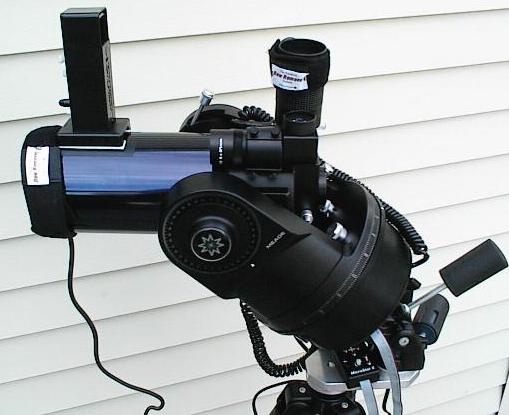


|
|

|
Since both my home and my primary observing spot at Frosty Drew Observatory are right along the coast of the Atlantic Ocean, I've been having a running battle with dew ever since I got my ETX. A dew shield from Scopetronix helps forestall the dew for a while, but wouldn't keep it off all night, especially if I was doing a lot of observing near the zenith. The final straw came on the night of May 21, 1999, when I was set up to observe an occultation of Regulus by the Moon. The dew was so bad I had to keep taking the ETX off the tripod and bring it to the car, where I would hold it up in front of the heater vent to dry off the correcter plate. I had to do this 3 times before the occultation occured at 12:17 AM, and I didn't even bother to wait for the star's reappearance, since that would have required a fourth trip to the heater.
So what's an ETX owner to do? Get a Kendrick Dew Remover System!
|
This system works by wrapping the heating elements around the particular parts of the telescope you want the dew kept off of. These elements, powered from a 12v DC power supply, heat the intended areas just enough so that the temperature is raised just slightly above the ambient temperature. This keeps the dew from forming on the exposed surfaces. In the picture to the right, you can see the elements wrapped around the corrector plate at the front of the telescope and around the eyepiece. |

|

|
The controller, shown to the left, has a cord with a 12v cigarette lighter plug attached to go into a 12v DC power source, and 4 jacks for heater elements to get plugged into. The controller's knob is both an on-off switch and is used to set the power output. This control is not a simple rheostat. Instead, it controls a duty cycle switch which turns the circuit on and off many times per minute. This is more efficient than running the circuit constantly with a variable resistor in the circuit. This way, on the low setting, the heater elements draw the same amount of current, only 40% of the time compared to the high (100%) setting. |
|
I've powered my Kendrick Dew Remover System with a 12v power pack from Scopetronix. It cost $69.95 in July, 1999, and comes with a recharger. This unit, actually a Whistler PP4000DC, will theoretically run my configuration for about 10 hours at full power. It has 2 outlets, making it very convenient for people running ETX/EC models to power both the scope and the Kendrick system at the same time. |

|
The system gets a little pricey, with the controller going for $64, the 3.5" main heater going for $38 and the eyepiece heater costing $33. These prices from Pocono Mountain Optics were correct as of July, 1999.
So how does it work? Extremely well. I have never had to run the system at anything other than the lowest setting to keep the dew off, even when items around me, such as my eyepiece case, got quite wet. At this setting, calculations give me a theoretical operation time of 24 hours! I was concerned at first about thermal effects on the telescope. Given that the ETX requires quite a bit of time to cool down in certain weather situations, I was afraid that I'd get some turbulence from the warmed-up optical elements. In fact, I have seen no sign of such distortion. The heating elements become only slightly warm to the touch, and the scope and eyepiece do not feel any warmer to the touch. The system works at simply keeping the corrector plate and eyepiece only slightly above the ambient temperature, avoiding condensation.
I am very happy with this setup, but I realize that spending over $200 to keep the dew at bay is not within everyone's budget. In my case, I ran into so many situations where my observing sessions were cut short by dew that I feel the purchase was a good one. It's nice to be able to continue an observing session while everyone else has had to pack it in because of the dampness. In fact, when I broached the subject of spending the money on the Kendrick system, my wife, who has no interest in astronomy or telescopes at all, agreed that I should get it. She'd heard me grumble about the dew so often that she remembered it as a distinct problem, rather than just another vague telescope complaint! This is a high-quality solution that is worth the money I spent.